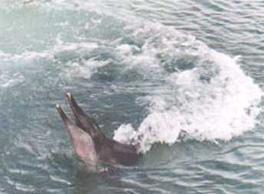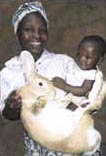Christmas in Hawaii is always a little different. Santa might wear flip-flops instead of boots, a red pareu (sarong) around his opu (stomach), a red hat, a red lei—and nothing else. At Hawaii's Sea Life Park, where I was head trainer for a decade in the '60s, we put on dolphin shows many times a day, and sometimes had big crowds of school children. Naturally, we thought of Christmas-type events: dolphins pulling Santa's sleigh—with gift-wrapped buckets of fish and a Hawaiian poi dog riding on top of the sleigh—that kind of thing. Read more about Sea Life Park.
My favorite Christmas show took place in the all-glass Ocean Science Theater, where you could see the whole tank underwater. One year we decided to teach Hou and Malia, two rough-toothed dolphins, to trim an underwater Christmas tree. We put the tree in a weighted pot in the center of the tank, on the bottom. We gave each dolphin a long gold garland. Holding one end of her garland in her mouth, Malia, the senior dolphin, swam in circles around the tree, from right to left and bottom to top, leaving the garland neatly wound in a spiral up the tree.
Then we gave Hou another garland and she circled the tree from left to right and top to bottom, leaving that garland neatly crisscrossing the first one. Then if I recall correctly, the dolphins took a bunch of plastic ornaments and put them on the tree too.

Rough-toothed dolphins, Steno bredanensis, are homely, blotchy brown animals with ugly faces, not at all cute like Flipper, but they are incredibly smart and very interested in learning. Trainers used to joke that all you had to do was to write the show plan on a blackboard and hang it in the tank. (SeaWorld trainers have the same joke about killer whales.)
Here's a sort of summary training session:
Dolphin: "You want me to do what? Go around that prickly thing [the tree] down there?"
Trainer clicks (only we used a whistle, which carries better under water).
Dolphin (swallowing fish and ready to try again): "Which way shall I go around? This way?"
Click.
Dolphin: "And starting where?"
Trainer gives a "go" cue as the animal approaches the bottom.
Dolphin: "Okay, got that."
Click/treat. Repeat.
"And now you're giving me a thing to carry?"
Trainer hands over the garland, animal takes it. Click. Fish.
Now a little time is allowed for the animal to get used to swimming around dragging the garland—oh, say, 10 seconds, you don't want the animal to get too interested and start playing 101 Things to do with a Garland.
Finally, give the garland, give the "go" cue, animal wraps it around the tree. Train animal #2. Put it in the show. Audience loves it. Merry Christmas.
The hardest part was getting the tree rigged so we could lower it from the ceiling into the tank when it was needed, and then raise it up out of the way again. That required getting Maintenance to show up with a crane and fasten ropes and a pulley to the Ocean Science Theater ceiling. Getting that 20-minute job onto their schedule took WEEKS of struggle.
Critters as presents
Last year Mary Lee Nitschke, a behaviorist friend of mine, sent my family a remarkable holiday present: a sort of Noah's Ark of animals, live animals, which were delivered, not to my apartment in Boston , but to several other families in underdeveloped areas around the world. One family in rural Asia got some very good chickens, enough to have eggs for the children and to raise, sell for much needed cash, and share with other families so they could start their own flock. Another family got a pregnant female goat, the start of a herd.
A third family got honeybees and some young plants of a flowering tree, much loved by bees, which will thrive in their area.

Heifer International is the name of the group that thought this one up. They give carefully bred varieties of livestock, suited to the area, which can live off crop waste and natural vegetation. They teach the family how to care for the animals. The only requirement is that some of the first offspring of the gift animals, plus the husbandry knowledge, must be passed on to another family that would benefit. A rabbit recipient tells his story.
And that's why my son the banker—who probably doesn't need another necktie, or a sweater, or an Orvis gift certificate—is getting a sheep for a holiday present. From me; but for a child in Romania. And my teenage granddaughters are getting ducks and chickens. From me; going to families in Asia .
And I'm just wondering whether I can spring for a young female llama. From all of us…to all of someone's family in Peru.
To find out more, visit the Heifer website or call 800-422-0474.



Post new comment